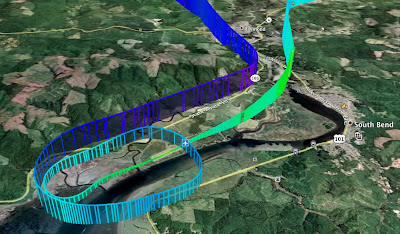By 1:00, we had just a few clouds at 1000 feet, and it was clearly improving further. My boss was kind enough to let me take a long lunch, and by 1:30 I was at the hangar watching the last few wisps of cloud evaporate. It was going to be a great day to fly!
It felt like the right day to tackle an airport I've been wanting to visit for the longest time: Willapa Harbor (2S9). I have actually visited this airport by car...when Michael and I went camping near the coast two summers ago, we drove by it on our way home and stopped in to check it out. It's your typical sleepy little out-of-the-way airfield, that is nonetheless a critical component of the transportation infrastructure for the Raymond-South Bend area. It offers terrific views of the bay best known for producing some of the best oysters in the world, and some interesting terrain nearby.
I flew pretty much direct from Olympia. There was a strong inversion at 2000 feet, below which visibility was maybe 10 miles in haze, but above which it was unlimited. A large wildfire was burning about 30 miles south of Raymond up in the Willapa Hills, and with light southerly winds, a plume of smoke was directly across my flight path. I held my final descent into Willapa Harbor until clear of the smoke, and planned an overhead entry into the pattern so I could get a good look at the windsock (since 2S9 does not have automated weather). The wind was maybe 8 knots, straight down runway 11, so I turned overhead for a left downwind, keeping it tight to avoid the terrain to the north of the airport. I actually overshot final just a bit, but not so much that I couldn't correct.
After a landing I was happy with, I departed straight out and turned direct for Kelso (KKLS), which is far enough away from Olympia to allow me to log cross-country time. (2S9 is only 46 miles from KOLM...4 short of the distance required to count as xc). Kelso was busy...a helicopter departed just as I began monitoring the frequency, 15 miles out...another Cessna was in the pattern...and a Citation jet was holding short as I landed. Good to see folks out enjoying the nice weather. The Cessna in the pattern was just turning downwind to leave as I was a couple miles out on the 45, so I decided to circle to the west to give him time to depart. I probably could have worked in behind him, but I figured to play it safe.
On the way back to Olympia, I flew over a solid stratus deck that extended from 10 north of Kelso to 10 south of Centralia. It was beautiful...serene...but also a little problematic if the fan quit turning, so I climbed to 6500 to give me more options. The Cascade peaks to the east--Rainier, St. Helens, Adams--were stunning on the horizon.
Back at the home patch, I practiced a no-flap landing, did a touch-and-go, and back around for a simulated engine-out landing.
Google Earth track is here.
One final note: 12 minutes out of Olympia, headed for Willapa, I crossed the 100 hour milestone. It was a perfect flight to do it!













